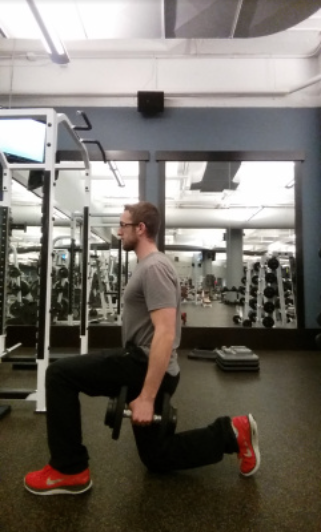Highly Rated Exercise: Stepback Lunge
Today’s guest post comes from James Harris of JamesHarrisTraining. He’s an up and coming writer who also works with me at the same club I work at, and has an even more off-putting sense of humour than I do!! Enjoy.
Ain’t no party like the step back party. SSSSSS-Club. I’m gonna show you how…awesome this exercise is.
This exercise is the bee’s knees. It has proven to work very well with people who are experiencing PFS (Patellofemoral Syndrome), otherwise classified as people having general pain around the kneecap. It also works well to apply tension to the hamstrings and glutes instead of primarily loading up the quads. For someone who is very quad dominant (a large majority of people are) this has worked exceedingly well to help develop some posterior chain dominance. It also works well to get some extra mass around the hamstring and glute area for those looking to add a little extra size to their backside.
Additionally, many rehabilitation studies have shown that PFS (Mascal et al. 2003)[^1](Lee et al. 2012)[^2] IT Band Syndrome (Fredericson et al. 2000)[^3], ACL injuries (Jacobs et al. 2007)[^4] and ankle instability issues have shown to be directly correlated to weak abductors and glute activation.The step back lunge is a good way to strengthen these stabilizer muscles (adductors/abductors) to help rehabilitate and further prevent such injuries. During a step back lunge, they work as co-contractors to keep the knee in line with the toes during both the concentric and eccentric phases of the exercise, as well as contributing to glute activation on the upward phase.
Step back lunges trump forward lunges when it comes to reducing shear force on the knee. The forward lunge drives the femur forward, creating almost a “gliding” effect, where the femur is pushed over the tibia, applying more pressure on the patella and it’s surrounding ligaments. Whereas in a step back lunge, the force is loaded more on the top end of the femur towards the hip, alleviating the majority of the pressure around the kneecap because the femur is pulling back from the tibia.
It’s a good idea to not play favourites with the types of lunges you do, as you should try to move in multiple directions. This creates better overall movement and strength in all areas instead of just one or the other. The only reason you’d want to avoid the step back lunge is if you are already too posterior chain dominant. In instances where you present with a possible posterior pelvic tilt (which you can read more about how to fix HERE), the hamstrings and glutes are already getting excess tension, so it’s unnecessary to add to anything to that. Someone who has an anterior pelvic tilt would likely benefit from this a lot, since more of a posterior chain dominance is necessary for evenly distributed hip strength.
A Quick Breakdown of How to Do the Step Back Lunge
Mechanically speaking, it’s very simple to set up. Start on the ground to get your stance set in your head, like this:
Creating two 90 degree angles with the knees, toes dug in, and neutral spine
From this position, you push off of the back leg driving through the back foot. Stand up onto the front leg into hip extension on said leg, then place the other foot on the ground. Keep the spine as neutral as you can when going through the motions.
Video Demonstration
How to Progress
BB Step Back Lunges [Front Loaded/Back Loaded]
DB Front Foot Elevated Split Squat
By elevating the front foot onto a low box, you simply add more range of motion for the hamstrings and glutes to go through, equating to more stress on the muscle, to get more of the gains. Get all of the gains.
How to Regress
Supported Step Back Lunge
If this still proves difficult, try foam rolling your legs for a couple of minutes beforehand. This should help “reset” the tone of the muscle, allowing it to be able to transit through the movement with less restriction.
Want to see more awesome highly rated exercises and why are they are the most awesomeness ever?! Tell me what you want to know!
James Harris is a Personal Trainer based of Edmonton, AB. Dealing highly in a post-rehabilitation setting, helping clients move, feel and perform better. He also helps them look jacked, swole and great in a bikini or speedo, no judgements.
You can subscribe to his blog at Jamesharristraining.wordpress.com or like his Facebook Fitness Page HERE.
References:
[^1]: http://www.jospt.org/doi/abs/10.2519/jospt.2003.33.11.647#.VOSkwy6vyEQ
[^2]: http://www.sciencedirect.com/science/article/pii/S0966636212001154
[^4]: http://www.ncbi.nlm.nih.gov/pmc/articles/PMC1896084/



5 Responses to Highly Rated Exercise: Stepback Lunge